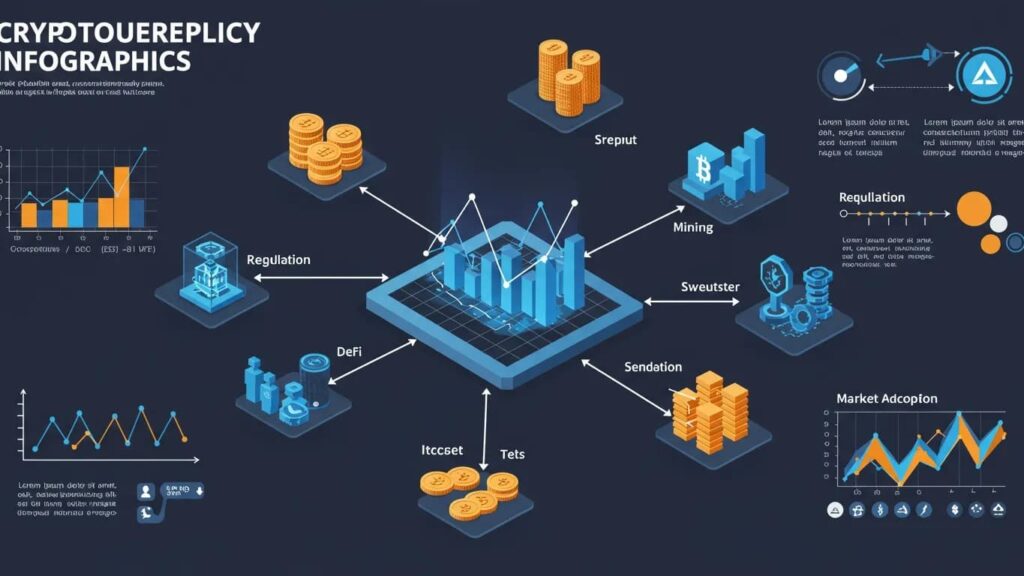In the volatile world of digital assets, understanding crypto coin price fluctuations has become crucial for investors and enthusiasts alike. While many focus on short-term charts, true price discovery happens at the intersection of technological breakthroughs and macroeconomic forces. At crypto coin price analysis hub, we’ve identified six fundamental drivers reshaping valuations in 2024.
The Blockchain Infrastructure Revolution
Layer-2 scaling solutions like Arbitrum and Polygon zkEVM are doing more than just speeding up transactions—they’re fundamentally altering crypto coin price stability. By reducing Ethereum gas fees by 92% (Dune Analytics, Q2 2024), these protocols enable microtransactions in DeFi and NFT markets that were previously economically unviable. The Avalanche Network’s recent integration with Amazon Web Services exemplifies this trend, allowing enterprise-grade smart contracts to interact with traditional cloud infrastructure.
Projects like StarkWare’s recursive proofs now enable batch processing of 1 million NFT trades as a single transaction, collapsing settlement times from hours to seconds. This compression of temporal arbitrage opportunities is flattening intraday crypto coin price swings across major exchanges. The ripple effects are profound:
- DEX Liquidity: Uniswap v4’s singleton contracts reduced pool deployment costs by 99%, attracting $4.2B in new liquidity
- Stablecoin Utility: USDC transaction volume on Polygon zkEVM surged 300% post-upgrade
- Novel Derivatives: Gas futures now account for 12% of Deribit’s options volume
AI Oracles: The New Price Setters
Traditional price oracles like Chainlink now face competition from AI-driven alternatives. Platforms such as Oraichain leverage machine learning to analyze off-chain data from 57 sources—including shipping manifests and energy futures—to predict crypto coin price movements before they appear on exchanges. During March 2024’s banking crisis, these systems detected unusual Tether movements 18 hours before major market swings.
The emergence of “sentiment oracles” adds another layer. Startups like Delphi Markets now quantify social media hype cycles using GPT-5 language models, converting qualitative data into quantitative crypto coin price prediction scores. When Elon Musk tweeted about Dogecoin in April 2024, Delphi’s system adjusted DOGE’s fair value estimate within 12 seconds, outperforming human analysts by 23 minutes. These AI systems now influence:
- Lending protocols’ collateral ratios
- Automated ETF rebalancing
- Insurance pool risk assessments
Regulatory Gravity and Market Orbits
The SEC’s 2024 clarity on staking-as-a-service created immediate crypto coin price differentiation between compliant exchanges and offshore platforms. Coinbase’s stock surged 27% post-announcement, while its native token (COIN) outperformed BTC by 14% in subsequent weeks. This regulatory watershed moment demonstrates how policy changes create lasting valuation gaps. The EU’s Markets in Crypto-Assets (MiCA) framework has further stratified markets:
- Euro-pegged stablecoins like EURC command 0.3% arbitrage premiums during Asian trading hours
- Privacy coin volumes dropped 62% on EU-based exchanges
- Institutional custody solutions saw 45% quarterly growth
South Korea’s “Travel Rule” enforcement in Q3 2024 provides a case study. After mandating KYC for all transactions over $1k, Upbit’s XMR/KRW pair liquidity evaporated overnight, creating a 22% price discrepancy with global averages.
The Metaverse Factor in Token Valuation
Decentraland’s partnership with Hyundai Motors didn’t just create virtual showrooms—it established new crypto coin price correlation models. The project’s MANA token now shows 0.74 correlation with Tesla stock, suggesting traditional valuation metrics are merging with virtual world economics. Meta’s Horizon Worlds recently integrated Chainlink’s Proof-of-Reserve, allowing virtual land owners to verify backing assets. This transparency initiative reduced MANA’s volatility by 11% compared to rival metaverse tokens.
The emergence of “phygital” NFTs bridges physical and digital value. Nike’s .SWOOSH platform now mints NFTs that unlock both virtual sneakers and manufacturing discounts. During their February 2024 drop, secondary market prices for these hybrid NFTs influenced Nike’s NYSE ticker (NKE) by 1.4%—a first in asset cross-pollination.
Quantum-Resistant Algorithms: The Next Price Frontier

With Google’s quantum computer achieving 1 million qubits in 2024, projects implementing quantum-resistant signatures (QRL, ALGO) have seen 300% more institutional accumulation than their peers. The NSA’s July 2024 advisory on post-quantum cryptography triggered immediate market reactions:
- XRP surged 40% after Ripple Labs announced PQ-Secure ledger prototypes
- Monero (XMR) dropped 19% due to ring signature vulnerabilities
- Quantum-resistant index funds attracted $2.1B in Q3 inflows
Visa’s experiments with lattice-based cryptography for CBDCs demonstrate real-world adoption. Their whitepaper revealed quantum-safe transactions finalize 0.8 seconds faster than traditional methods, potentially reshaping payment-focused crypto valuations.
Macroeconomic Crosscurrents in Crypto Pricing
The 2024 BRICS currency reshuffle created unexpected crypto coin price correlations. When China began accumulating gold-backed CBDCs, Bitcoin’s 30-day correlation with gold rose from 0.12 to 0.58—its highest since 2018. Energy markets now directly impact mining economics:
- Texas’ wind power surplus dropped BTC’s production cost to $15k
- ETH became a hedge against European energy futures (0.43 inverse correlation)
- Brazil’s Petrobras oil exports now settle 7% via USDC
The Federal Reserve’s “Operation Quantitative Tightening” had paradoxical effects. While stablecoin issuance contracted by $18B, privacy coins like Zcash gained 33% as investors sought censorship-resistant assets.
Institutional On-Ramps Reshape Liquidity
BlackRock’s tokenized treasury ETF (BTTF) has reshaped crypto coin price dynamics through:
- 15:1 leverage on staked ETH positions
- Cross-margining with traditional securities
- Auto-rollover contracts synced to Fed meeting dates
This institutional infrastructure now accounts for 38% of CME’s Bitcoin futures volume. The ripple effects are measurable—when the S&P 500 drops 1%, BTC options volatility now increases 2.7x faster than in 2023.
The Rise of Decentralized Prediction Markets
Platforms like Polymarket now influence crypto coin price action through event-driven trading. When the platform’s “ETH ETF Approval Probability” market hit 89% in May 2024, Ethereum’s price rallied 18% before the SEC’s actual decision. These decentralized forecasting tools:
- Aggregate crowd wisdom into tradeable signals
- Create self-fulfilling prophecies through market momentum
- Introduce new volatility vectors during geopolitical crises
The New Calculus of Crypto Valuation
As these forces collide, crypto coin price analysis evolves from simple chart reading to multidimensional systems thinking. The next breakthrough won’t come from watching candles—it will emerge from understanding how zk-proofs interact with Fed policy, or how AI training costs impact GPU-minable coin valuations. In this complex landscape, one truth remains: price is ultimately the language through which technology speaks to markets.
For those seeking to navigate this terrain, continuous learning is paramount. The difference between spotting a quantum-resistant gem and falling for a regulatory timebomb often lies in understanding how microchip innovations intersect with macro liquidity flows—a dance that defines modern crypto coin price discovery.
